Intel 925X Roundup: Creative Engineering 101
by Wesley Fink on August 12, 2004 12:05 AM EST- Posted in
- Motherboards
DirectX 9 Gaming Performance
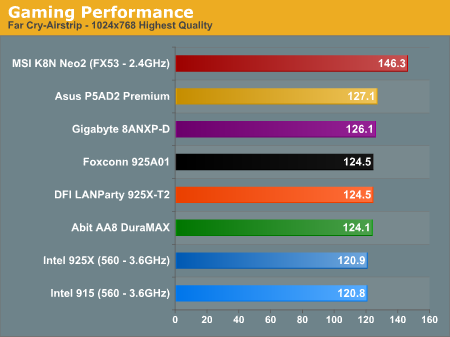
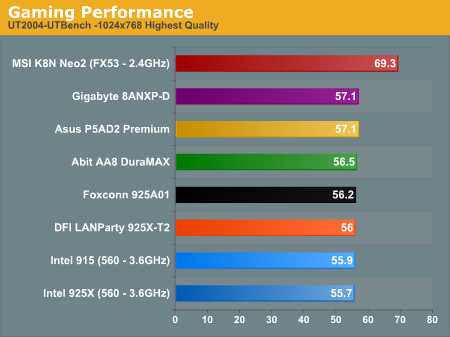
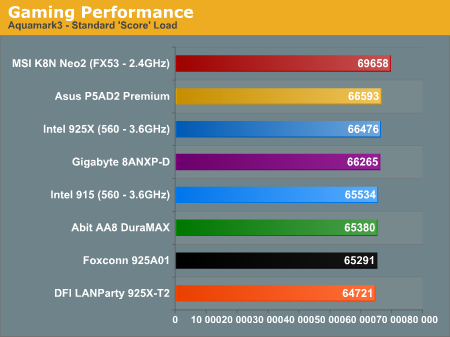
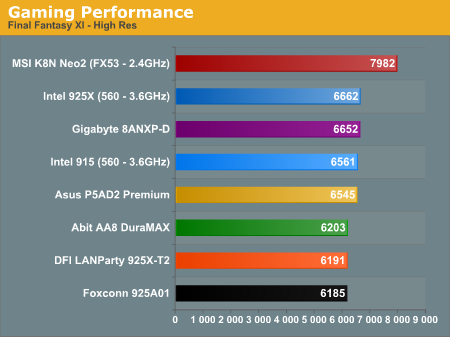
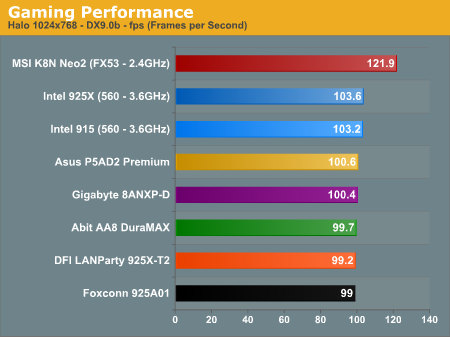
After the close scores in Winstones, we really did not expect much variation in game benchmarks. As we have said before, expectations can lead to wrong conclusions. As you look across the DirectX 9 gaming benchmarks, the Asus P5AD2 and Gigabyte 8ANXP-D are always number 1 and number 2. They switch positions in a few benches, but across the board, it is generally Asus, Gigabyte, then everyone else. This is particularly intriguing, since both the Asus and Gigabyte boards are the two premium boards in the roundup.
The other three boards seem to shift positions, but none of others really stand out like the Asus and Gigabyte in these benchmarks of the most recent DX9 games. None of the 925X boards can really keep up with the Athlon 64 FX53, but we already knew that from results of the Socket 939 Roundup.










30 Comments
View All Comments
JustAnAverageGuy - Thursday, August 12, 2004 - link
On the Gigabyte 8ANXP-D:Page 10
Memory Slots Four 240-pin DDR2 Slots
Gigabyte provides 6 DIMM slots, but the total memory and number of sides that can be used is the same as the other boards in the roundup.
JustAnAverageGuy - Thursday, August 12, 2004 - link
Typo page 5:"The memory stress test measures the ability of the Abit AA8 to"
should read Asus P5AD2. :)
only on page 5, may be more.
l3ored - Thursday, August 12, 2004 - link
allright, point taken. howabout testing lower lga775 cpus and combining the results with 939 scores?Wesley Fink - Thursday, August 12, 2004 - link
#5 - You're welcome.We also ran and reported the rest of our standard motherboard tests, which included Business and Multimedia Content Creation Winstones and Media encoding (which Intel won by a small margin).
As we stated in the review the only reason we did not include our standard SPECviewperf 7.1.1 benchmarks is because we have seen variations of up to 100% in SPECviewperf results with certain 925X boards. We don't believe these results are real, and we are trying to find answers for these variations in benchmark results. Until we find some answers, publishing the workstation benchmark results would not really reveal anything about the performance of the 925X boards we are testing.
The FX53, Intel 925X, and Intel 915 results are included for reference and completeness. We are comparing five 925X motherboards in performance, and we do not mean to detract from that comparison with AMD Socket 939 benchmarks. Please consider the 939 results to be a frame of reference.
AnnoyedGrunt - Thursday, August 12, 2004 - link
From what I can see, the P4 560 is about $750, so that puts it right between the 3800+ (about $650) and the FX-53 (about $850) in price. It would be nice to add the 3800+ scores (if you have any) to that review just so we could see how the price/performance of the 560, 3800+, and FX-53 compare.-D'oh!
Shimmishim - Thursday, August 12, 2004 - link
#2 - Achieving a 4 ghz overclock on a pentium is nothing to sneeze at... i think 3.8 may be possible on air but 4.2 is really pushing.As much as a lot of us would love to see overclocked processor results, i think it's best that they only show stock clock results as they are easier to compare...
#3 - Its hard to say how fair it is to use a FX-53 against the 3.6 ghz 775 chip... but if you think about it, they are comparing the top end pentium 775 skt (new pin count) vs. the top of the line A64 939 skt (new pin count)..
Both are also 1 megs of L2 even though the extra cache doesn't help the A64 greatly.
Maybe a 3800+ would have been better comparison but i think he was trying to make things as easy to compare as possible...
Even if he had used a 3800+ or even a 3700+ i don't think the gaming results would have been that much different... we all know that the A64's dominate in gaming.
maybe some more tests besides gaming would have been better...
but all in all...
thank you Wes for a good article!
Wesley Fink - Thursday, August 12, 2004 - link
#3 - The 3.6 is the fastest Intel processor. If you will check our launch reviews you will see the 3.6 outperformed the 3.4EE. We are indeed comparing the best performing Intel - the 3.6 - to the best performing AMD - FX53.Prior to the 3.6, the 3.4EE was the fastest Intel CPU.
l3ored - Thursday, August 12, 2004 - link
lately i've been noticing unfair comparisons between intel and amd, in this article, high end processors are being compared with the top of the line from amd. this isnt really helpful to anyone, so please go back to the old anandtech way.Anemone - Thursday, August 12, 2004 - link
Nice article !If I could have had one extra wish it would have been to show a set of test charts with a moderate oc on them, think that would put the FX @ 2.6-2.7 and the P4 560's @ 4.2-4.3.
If the boards can overclock, and the 939's can too, where does it all land for those using just normal or at most water oc'ing.
No worry, these wishes do not detract from a very nice article.
Thank you
stickybytes - Thursday, August 12, 2004 - link
Nice to see asus get a award but unfourtanetly the word "prescott" mentioned in any sentence will probably scare away 80% of AT'ers.